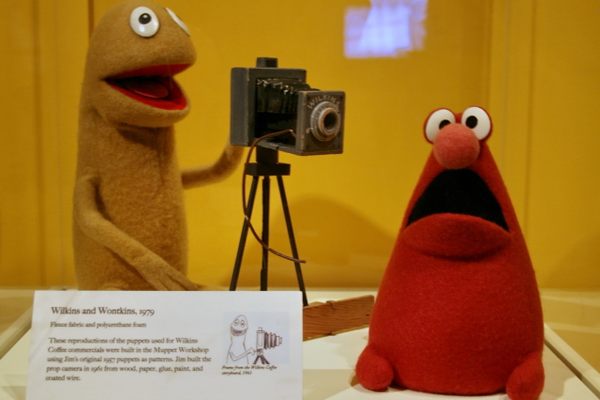What’s a 1956 General Motors Ad Doing in ‘The Stepford Wives’ And Super Mario?

A still from General Motors’ 1956 promotional film Design for Dreaming. (Photo: USAutoIndustry/YouTube)
In 1956 General Motors released a promotional film called “Design for Dreaming”. According to GM’s Heritage Center, the film was one of a series of annual shorts that the company made to show off their yearly Motorama show—an event that showcased not just cars, but other General Motors ideas about how the future might unfold. That year there were 63 exhibits and 26 cars on display, sprawling across 26,000 square feet of the Waldorf Astoria hotel in New York City. And the film’s purpose was to promote GM and Motorama, as the show prepared to travel across the United States.
Design for Dreaming did all that, but unlike other commercials from the 1950’s, there was something about this little film that has lingered on. It’s been used in music videos, documentaries, big blockbuster movies and more. You’ve probably seen clips from Design for Dreaming without even realizing it.
Here’s how, and why, it became such a cult classic.
Design for Dreaming runs nine minutes and sixteen seconds. It opens with a woman (Tad Tadlock, who also choreographed the whole film) asleep in her room, before a masked man appears through her closet and invites her to the GM Motorama show at the Waldorf.* She’s magically given a ball gown to wear, and is whisked away to the show. There, she ogles all the new GM models, a Corvette, a Buick, a Pontiac. Her masked magic man promises her one of each, when suddenly an apron appears over her ball gown and she faints. “Better get her to the kitchen quick!” a man shouts, and so she’s whisked again away.
She wakes in the Frigidaire kitchen of tomorrow (available to tour at Motorama show) and marvels at all the futuristic appliances. In this kitchen of the future, there’s no need to mix ingredients, just put a card in the slot and push a few buttons and, voila, a cake is made! She blows out the candles and is transported back to the Waldorf where the show is still going on. The film ends with her and her now-unmasked beau riding on the “electric highway of the future” off into the distance.
Oh, and the whole thing is a musical.

An advertisement for the 1956 Motorama. (Photo: Alden Jewell/flickr)
Design for Dreaming was directed by a man named William Beaudine, one of Hollywood’s most prolific directors, but certainly not its most revered. Over his career, which spanned from 1915 to 1966, Beaudine directed almost 350 films. These included films you’ve likely heard of, like Lassie and The Adventures of Rin Tin Tin. But they also include lesser known films like Jesse James Meets Frankenstein’s Daughter,Billy the Kid versus Dracula and Bela Lugosi Meets a Brooklyn Gorilla. After his death he was given the nickname “One-Shot Beaudine” for his tendency to only film a scene once, regardless of how it went.
This technique allowed him to deliver films regularly on-time and on-budget, but it also meant that movies hit the silver screen with some interesting fumbles. In Billy The Kid Versus Dracula, there is a scene in which Dracula should have been lit from the front by a stagehand, but, instead the light bounces all over the wall, on the top of his head, behind him, directly into his face. Beaudine opted against another take. In Design for Dreaming, at some point Tadlock tears the back of her dress, and steps on the rip several times throughout the rest of the filming.*

Director William Beaudine also made films such as Lassie, and the lesser-known Billy The Kid vs Dracula. (Photo: YouTube)
Most of Beaudine’s films have long been forgotten except to fans of camp and the 1950’s B-list. (Including more scandalous fare: a 1945 film called Mom and Dad, about a girl whose parents don’t teach her about sex and then gets pregnant via another teen who then dies, was shown in sex-ed classes through the ‘70s.)
But for some reason, Design for Dreaming has taken on a life of its own. Filled with fantastical, strange and campy imagery, it’s hard not to enjoy watching it, even for all its sexism and oddity.
On Archive.org, the reviews are largely positive. “I love this film, play it all the time,” says one person. “I love the songs in this film, and I watch it often. I think that anyone who gets the chance should watch this film, as it’s lots of fun,” writes another. “Easily the greatest movie ever made about the American way of life. as the previous 14 reviews indicate.”

Design for Dreaming showcased GM’s latest cars. (Photo: USAutoIndustry/YouTube)
But it’s not just random people on the internet who love Design for Dreaming (although they certainly do). The film has a long tail that few other commercials attain.
In 1986, Peter Gabriel used a clip of the commercial in his music video “In Your Eyes”. In 1989 Rush used the ad in their video for “Superconductor,” directed by Gerald Casale.
When I asked Casale why he picked Design for Dreaming, I thought he might not remember the GM film specifically. It might have just been another commercial pulled and slipped into the video. But he remembered quite clearly. “I loved that piece because it is supremely produced, naive, futuristic propaganda for the future we were promised in the 50s [sic] but never got,” he told me in an email. “Instead of that future we got dystopia and coals in our collective Christmas stockings. I believe the film was premiered at the Waldorf Astoria Motorman show sponsored by GM. The combination of advertising with an extended musical-based film sequence shot with color 16mm film is curiously Hi meets Low culture that transcends kitsch.”
In that same year, the film found its way into a Super Mario Land 1 commercial, as Mario bounces around ancient castles and the home of tomorrow.
In 1992, director Adam Curtis released a documentary series called Pandora’s Box: A Fable From the Age of Science. It ran on BBC television, and the idea behind the series was to take a look at what happens when people embrace technologies and political ideas, without really thinking them through — and over the course of six parts, it explores everything from game theory during the cold war, to DDT, to nuclear power. The title sequence of the show features heavy use of Design for Dreaming.
In 1994 a clip was used in a Power Macintosh Ad, and that same year the film was featured in an episode of Mystery Science Theater 3000 — another cult classic of its own that ran from 1988 to 1999. The premise of MST3K, as fans call it, is that a man and his robotic companions are captured by mad scientists and forced to watch B movies until they go mad. In the Design for Dreaming short, like many others, the three sit silhouetted in front of the movie screen, offering snarky commentary on the film. They call Thadwick’s character Nuveena, and she shows up in live-action form later in the episode played by Briget Jones. The character spawned a little logo and even a shirt depicting her short bob and the highway of tomorrow.
In the 1997 movie The Game, the main character watches Design for Dreaming during a physical exam. In 2004, the movie The Stepford Wives used the commercial in the title sequence and in 2006, the movie The Hills Have Eyes did the same. In that same year, Nine Inch Nails played clips of the commercial in their concerts. No one from the band responded to my requests for comment, but fans on the Nine Inch Nails subreddit pointed me to their With Teeth tour, during performances of “Right Where it Belongs”, and, sure enough, the masked man makes an appearance.
Then there are the more recent, more internet-culture takes on the commercial. There’s a whole genre of YouTube videos that take modern songs and place them on top of the visuals from Design for Dreaming. Everything from the Arcade Fire song “Sprawl II,” toMagnetic Fields’s “Three-Way”. Most of these are more complex than simply dropping new audio on top of the existing video, too—they actually edit Design for Dreaming to fit the song, picking the choice moves.
And of course there’s the Tumblr GIF repository, full of looping scenes from the film.
This is all to say that something about this little film has stuck to us. Often, we use it as a stand in for things: for retro-futurism, naiveté, for whimsy, for kitsch but also for upper class living at the time. It’s become a visual signature that says “look how foolish and optimistic we were, little did we know that our future wouldn’t be so bright.”
Design for Dreaming does have a sequel, made five years later called “A Touch of Magic”. A Touch of Magic is a bit weirder than Design for Dreaming. It opens with Tad Tadlock (the heroine of Design for Dreaming, and the choreographer again on this film) and James Mitchell, dancing around a little cardboard model of the Motorama show before transporting to the past where Mitchell battles the evil jester, a Godzilla-like monster, and wins the fair maiden, Tadlock. All, of course, to song.
But for its strange time traveling (at one point the dragon appears in the car with them as a merry passenger, and the evil wizard grabs a drink at their housewarming party) and magical weddings, something about A Touch of Magic didn’t quite capture the imagination quite the same way. It didn’t encapsulate the 1950’s idealism for the future, its obsession with efficiency, it’s strange sense of fun and fashion in the same way. And so while Design for Dreaming still shows its head all over the place, A Touch of Magic is largely forgotten.
There’s a line in Design for Dreaming that I think about all the time. “Everyone says the future is strange, but I have a feeling some things won’t change,” sings Tadlock. The future is, of course, strange, but she was right too. Some things didn’t change — our constant appetite for happy futures, our strange designs, our quest towards automated kitchens and electric highways. And Design for Dreaming will stick around too, popping up to remind us of that eternal optimism.
If you’ve seen Design for Dreaming in a place we failed to mention, let us know. We’ll update this post with any other sightings as they come in. Here is a partial list below:
Peter Gabriel (starting at 2:51)
Rush, “Superconductor”(starting at 3:42)
1989 Super Mario Land 1 commercial (starting at 0:18)
1994 Power Macintosh Ad
*Correction: This post previously misspelled Tad Tadlock’s surname as “Thadlock” in two locations.



























Follow us on Twitter to get the latest on the world's hidden wonders.
Like us on Facebook to get the latest on the world's hidden wonders.
Follow us on Twitter Like us on Facebook